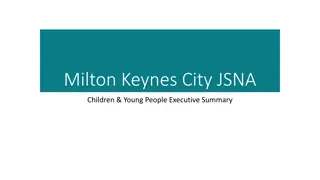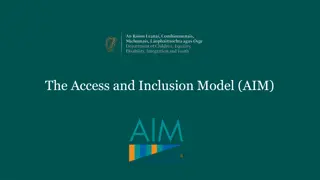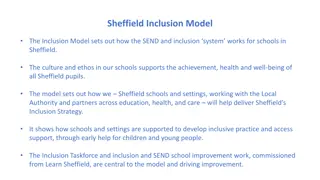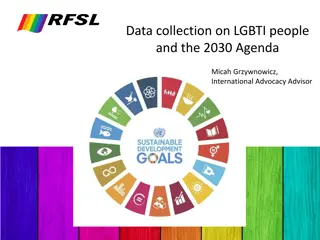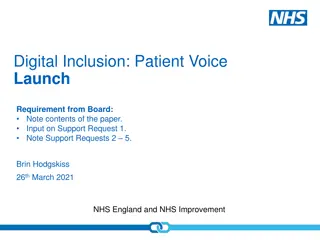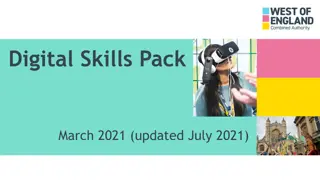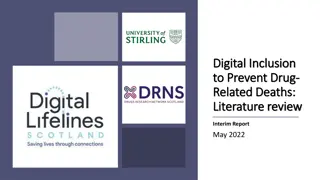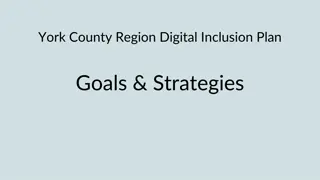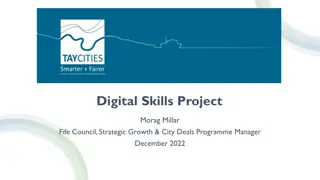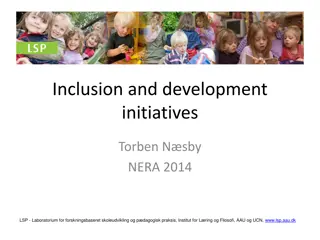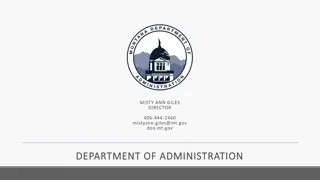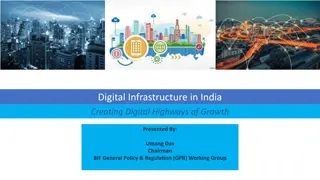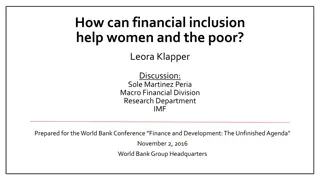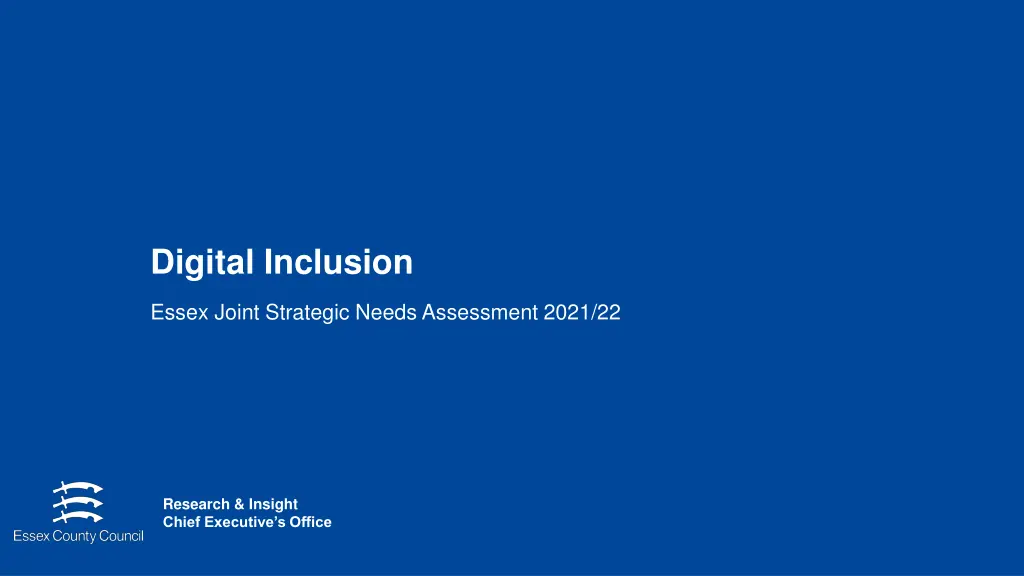
Digital Inclusion in Essex: Insights and Trends
Explore the findings of the Digital Inclusion Essex Joint Strategic Needs Assessment 2021/22, highlighting population statistics, local government structure, and barriers to internet use. Understand the importance of digital skills in today's evolving landscape and how digital exclusion can lead to various negative impacts. Discover the key barriers to achieving digital inclusion according to recent research.
Download Presentation

Please find below an Image/Link to download the presentation.
The content on the website is provided AS IS for your information and personal use only. It may not be sold, licensed, or shared on other websites without obtaining consent from the author. If you encounter any issues during the download, it is possible that the publisher has removed the file from their server.
You are allowed to download the files provided on this website for personal or commercial use, subject to the condition that they are used lawfully. All files are the property of their respective owners.
The content on the website is provided AS IS for your information and personal use only. It may not be sold, licensed, or shared on other websites without obtaining consent from the author.
E N D
Presentation Transcript
Digital Inclusion Essex Joint Strategic Needs Assessment 2021/22 Research & Insight Chief Executive s Office
Local Government Structure in Essex Essex operates under a two-tier system, with one county council and 12 district councils: Population and number of dwellings by administrative area: Essex and Greater Essex (2020)1,2 Number of dwellings2 Area Administrative geography All ages Age 18+ Age 16-64 Basildon Chelmsford Maldon 187,558 143,316 115,403 78,608 Basildon Non-metropolitan District Braintree Colchester Rochford 153,091 120,353 92,272 66,496 Braintree Non-metropolitan District Brentwood Epping Forest Tendring 77,242 60,939 47,161 33,757 Brentwood Non-metropolitan District 90,524 72,964 51,883 38,902 Castle Point Non-metropolitan District Castle Point Harlow Uttlesford 179,549 141,180 110,478 77,895 Chelmsford Non-metropolitan District 197,200 156,270 126,176 82,527 Colchester Non-metropolitan District The Essex County Council administrative area is referred to throughout this report as Essex . 132,175 104,005 80,919 56,988 Epping Forest Non-metropolitan District 87,280 65,411 53,914 38,823 Harlow Non-metropolitan District 65,401 53,311 38,034 29,026 Maldon Non-metropolitan District In addition, there are two unitary authorities - Southend-on-Sea and Thurrock which work as a single tier of local government. 87,627 70,599 52,177 36,327 Rochford Non-metropolitan District 147,353 120,273 79,178 71,042 Tendring Non-metropolitan District The area covering the three local authority areas of Essex, Southend-on-Sea and Thurrock is referred to throughout this report as Greater Essex . 92,759 72,095 56,162 38,493 Uttlesford Non-metropolitan District 648,884 1,497,759 1,180,716 903,757 Essex TOTAL County 648,884 1,497,759 1,180,716 903,757 Essex County 182,773 143,037 111,234 81,291 Southend-on-Sea Unitary Authority Thurrock Unitary Authority 175,531 130,150 110,202 68,292 798,467 1,856,063 1,453,903 1,125,193 - Greater Essex TOTAL 1 ONS mid-year population estimates 2020. Available at: https://www.nomisweb.co.uk/datasets/pestsyoala 2 https://www.ons.gov.uk/peoplepopulationandcommunity/housing/datasets/subnationaldwellingstockbytenureestimates 30/05/2022 | 2 Produced by Essex County Council Chief Executive s Office
Contents 1 Introduction 2 Connectivity, access and use 3 Barriers to internet use and digital participation
Introduction More than ever before, services, including public services and business transactions, are moving online. Concerns about the digital skills gap have been particularly acute during the COVID-19 pandemic as people have been more reliant on digital skills for work, accessing education and services, and socialising with friends and family. It has been widely highlighted that digitally excluded people may experience a range of negative impacts, including reduced access to education and employment, financial disadvantage and exclusion, poorer health outcomes and social isolation.1 Research for the UK Digital Strategy 20172 suggested that there are four key barriers to digital inclusion, and more than one may affect individuals at any one time: Access: the ability to connect to the internet and go online (affordability and access to devices, accessibility, coverage and good connectivity) Skills: the ability to use the internet and online services Confidence: a fear of crime, lack of trust or not knowing where to start online Motivation: understanding why using the internet is relevant and helpful 1 See for example: https://www.goodthingsfoundation.org/the-digital-divide/ 2 https://www.gov.uk/government/publications/uk-digital-strategy/uk-digital-strategy 30/05/2022 | 5 Produced by Essex County Council Chief Executive s Office
The impacts of digital skills on outcomes1 The impacts of digital skills on outcomes include benefits for employment, earnings, personal finance, access to government services, health, and community engagement (all of which are seen to affect health outcomes). Employment Digital skills can improve an individual s capability and efficiency at work, and lower the risk of job loss due to automation. Digital skills can allow people to adopt more flexible working arrangements via remote working and distance learning. Digital skills are associated with higher earnings. For those who are unemployed, digital skills can help people to find work and improve their employment prospects, including searching and applying for a wider range of vacancies online. Personal finance Digital skills and access to the internet can have substantial financial benefits. These include allowing people to manage their money through online banking, accessing financial and debt advice, saving money through online shopping and using online tools to compare the prices of goods and services. Access to Government support services Over the last decade, the UK Government and local councils have increasingly been encouraging people to access their services online, including managing benefit claims. However, research shows that the people most likely to require government support services are often from groups with lower levels of digital skills. Health and wellbeing Offering health and wellbeing services online can be more convenient for users, reduce demand on services and help make cost savings. The COVID-19 pandemic has meant that many healthcare appointments are now being carried out virtually by phone or video call. Digitally excluded people are at risk of worse health outcomes and worse access to healthcare services. Communication and social engagement Digital skills offer a wide range of ways to communicate with friends and family and can facilitate social and community engagement. There are concerns that those without digital skills are at greater risk of social exclusion and may not be able to access support networks as readily. This has been a particular concern during the pandemic, with many social and community activities moving online. 1 Source: UK Parliament POSTnote (number 643) - Developing essential digital skills. Available at: https://researchbriefings.files.parliament.uk/documents/POST-PN-0643/POST-PN-0643.pdf 30/05/2022 | 6 Produced by Essex County Council Chief Executive s Office
Connectivity, access and use
Connectivity (fixed broadband) Percentage of residential premises unable to get decent broadband from fixed broadband (2021)2 The UK government defines a decent broadband service as one that delivers at least 10 Mbit/s download speed and 1 Mbit/s upload speed. This is the level of connection deemed necessary for consumers to participate in a digital society.1 Broadband can be delivered to households via: 1. A fixed broadband connection 2. Fixed Wireless Access (FWA) - fixed connections between users premises and wireless telecommunication networks Across Essex and Greater Essex, 1.1% of residential properties are unable to get decent broadband from a fixed connection, which is lower than the England average of 1.3%. The proportion of residential properties unable to get decent broadband from a fixed connection is highest in Uttlesford (2.5%), Maldon (2.1%) and Colchester (1.7%). Number of residential premises unable to get decent broadband from fixed broadband (2021)2 Across the whole of Essex, 7,436 residential properties are unable to get decent broadband from a fixed connection (8,430 across Greater Essex), of which 1,408 are in Colchester. Across South Essex (Southend, Castle Point, Rochford, Basildon and Brentwood), only 1,419 residential properties are unable to get decent broadband from a fixed connection. Including connections from Fixed Wireless Access, just 0.1% of residential properties in Essex (923 properties) and Greater Essex (948) are unable to get decent broadband from either a fixed or FWA connection (not shown on charts). 1 Source: Ofcom Connected Nations 2021. Report available at: https://www.ofcom.org.uk/research-and- data/multi-sector-research/infrastructure-research/connected-nations-2020/main-report. 2 Local authority decent broadband (fixed connection) data available at: https://www.ofcom.org.uk/research-and- data/multi-sector-research/infrastructure-research/connected-nations-2021/interactive-report 30/05/2022 | 8 Produced by Essex County Council Chief Executive s Office
Internet access (ONS estimates - Great Britain 2005-2020) Access to the internet is the ability to connect to internet services through any internet enabled device, such as a laptop, tablet, smartphone or smart TV and via any type of internet connection such as broadband or mobile network.1 Since 2005, the proportion of households in Great Britain with internet access has increased from 55% to 96% in 2020. Data is not published at lower level geographies. Proportion of households in Great Britain with internet access (2005-2020)2 1 https://gss.civilservice.gov.uk/policy-store/internet-access/ 2 Source: Office for National Statistics data on Internet access (households and individuals) from the ONS Opinions and Lifestyle Survey. Available at: https://www.ons.gov.uk/peoplepopulationandcommunity/householdcharacteristics/homeinternet andsocialmediausage/datasets/internetaccesshouseholdsandindividualsreferencetables 30/05/2022 | 9 Produced by Essex County Council Chief Executive s Office
Home internet connection (UK) Ofcom s Technology Tracker Survey (conducted in February-March 2021) reported that 94% of households in the UK had internet access (a figure similar to the ONS UK 2020 estimate). It explored how households connect to the internet at home, with 92% of households with internet access equivalent to 86% of all households having a fixed broadband connection. Method of connecting to the internet at home (Ofcom Technology Tracker Survey 2021)1 Which of these methods does your household use to connect to the internet at home? % of UK households with internet access at home % of all UK households With any internet access at home* 100% 94% Fixed Broadband through a phone line or cable service perhaps using a Wi-Fi router to go online, via any device 92% 86% Mobile Broadband from a mobile network connecting via a USB stick or dongle or Mobile Wi-Fi router, or built in connectivity in a laptop or netbook or tablet computer with a SIM card 16% 15% NET: Fixed or Mobile Broadband 94% 89% Access to the internet using a mobile phone or smartphone using your phone s 3G or 4G or 5G mobile network 49% 46% Accessing the internet on a device such as a laptop or tablet using your mobile phone s internet connection known as tethering 21% 20% Mobile or tethered access only 6% 5% * Respondents were asked Do you or does anyone in your household have access to the internet at HOME (via any device, e.g. PC, mobile phone etc)? 1 Source: Ofcom Technology Tracker Survey 2021 (3,126 UK adults aged 18+ via telephone in Feb/Mar-21). Data tables available at: https://www.ofcom.org.uk/__data/assets/pdf_file/0022/216733/technology-tracker-2021-cati- omnibus-survey-digital-exclusion-data-tables.pdf Findings reported in: https://www.ofcom.org.uk/__data/assets/pdf_file/0013/220414/online-nation-2021-report.pdf 30/05/2022 | 10 Produced by Essex County Council Chief Executive s Office
Internet use (ONS estimates Greater Essex 2014-2020) Recent internet users are defined as adults who have used the internet within the last 3 months. Lapsed internet users are adults who used the internet more than 3 months ago. Non-users are adults who have never used the internet. Internet usage measured by the proportion of adults who have used the internet within the last 3 months increased in Greater Essex from 86.1% in 2014 to 93.7% in 2020, mirroring the growth trajectory seen nationally. Recent internet users (2014-2020)1 Recent internet users Lapsed internet users Greater Essex Non-users 2014 86.1% 2.2% 11.7% 2015 87.2% 1.9% 10.5% 2016 87.9% 2.6% 9.4% 2017 91.2% 2.1% 6.7% 2018 89.0% 1.5% 9.4% 2019 92.2% 1.8% 5.9% 2020 93.7% 1.9% 4.4% 1 Source: Office for National Statistics Internet Users, 2020: Published 6th April 2021. Dataset available at: https://www.ons.gov.uk/businessindustryandtrade/itandinternetindustry/datasets/internetusers Internet usage estimates are derived from the Labour Force Survey (LFS) Quarter 1 (Jan-Mar) each year. Some percentages sum to less than 100% due to "don't know" responses. 30/05/2022 | 11 Produced by Essex County Council Chief Executive s Office
Internet use (Essex Residents Survey 2020) The Essex Residents Survey 20201 found that 91% of Essex residents said they personally used the internet (broadly similar to the ONS estimate for Greater Essex).2 Internet use Essex residents by district (Essex Residents Survey 2020)1 Do you personally use the internet? (Yes/No) By district, use of the internet was more widespread amongst residents in Brentwood, Chelmsford, Rochford, Braintree and Colchester (all between 93-94%), whilst Tendring (86%), Basildon (87%) and Harlow (88%) had the lowest rates of internet use. 1 The Essex Residents Survey (2020) interviewed 3,021 Essex residents (excluding Southend and Thurrock) via a postal questionnaire, with data weighted to ensure responses were representative of the Essex adult population (aged 18+). A data dashboard is available at: https://data.essex.gov.uk/dataset/20m99/essex-residents-survey 2 All survey data is subject to a margin of error, plus the estimates included in this report from ONS, Ofcom and the Essex Residents Survey all employ varying methodologies, question wording, data collection periods and geographies, which means that estimates between different sources are likely to vary slightly. 30/05/2022 | 12 Produced by Essex County Council Chief Executive s Office
Internet users and non-users (Essex Residents Survey 2020) (1) Internet use Essex residents by age (Essex Residents Survey 2020)2 Do you personally use the internet? (Yes/No) A range of studies show that certain groups are more likely to be non-internet users and/or digitally excluded than others, based on factors including age, gender, disability, income, socio-economic status and education.1 Age age is consistently seen as the main factor determining internet usage and digital skills (see following pages), with higher levels of non- usage and lower levels of digital skills seen amongst those aged 65+ and particularly amongst those aged 75+ (see chart right). Gender although lower levels of internet use are sometimes reported for females (see for example ONS 20191), notable gender differences are only really seen amongst the 75+ age group, with similar levels of usage otherwise seen between females and males. For example, the 2020 Essex Residents Survey found that 54% of females aged 75+ used the internet compared with 65% of males aged 75+2. Similarly 2020 ONS estimates for England showed 43% of females aged 75+ were non- internet users compared with 33% of males aged 75+3. 1 Office for National Statistics (2019) Exploring the UK s digital divide . Available at: https://www.ons.gov.uk/peoplepopulationandcommunity/householdcharacteristics/homeinternetandsocialmediausage/articles/exploringtheuksdigitaldivide/2019-03-04 2 The Essex Residents Survey (2020) interviewed 3,021 Essex residents (excluding Southend and Thurrock) via a postal questionnaire, with data weighted to ensure responses were representative of the Essex adult population (aged 18+). A data dashboard is available at: https://data.essex.gov.uk/dataset/20m99/essex-residents-survey 3 Office for National Statistics Internet Users, 2020: Published 6th April 2021. Dataset available at: https://www.ons.gov.uk/businessindustryandtrade/itandinternetindustry/datasets/internetusers 30/05/2022 | 13 Produced by Essex County Council Chief Executive s Office
Internet users and non-users (Essex Residents Survey 2020) (2) Long-term limiting illness or disability the 2020 Essex Residents Survey found that 91% of working-age adults (aged 18-64) with a limiting long-term illness, disability or infirmity personally used the internet, compared with 98% of working-age adults without a limiting long-term illness, disability or infirmity (see chart right). Internet use Essex residents by presence of a limiting long-term illness (LLTI) or disability within age (Essex Residents Survey 2020)1 Do you personally use the internet? (Yes/No) Income the 2020 Essex Residents Survey found that, amongst working- age residents (aged 18-64): 86% of those with a household income of under 15,000 personally used the internet 96% of those with a household income of between 15,000 and 24,999 personally used the internet 100% of those with a household income of 25,000 and over personally used the internet Levels of deprivation the 2020 Essex Residents Survey also showed variations in internet use based on the Index of Multiple Deprivation (IMD)2, with 88% of residents living in the 40% most deprived areas nationally saying they used the internet, compared with 95% of those in the 40% least deprived areas nationally . However, differences in internet usage by IMD were seen most markedly amongst residents aged 65+, as shown below. 40% most deprived areas 40% least deprived area Essex All Essex Working age (18-64) 96% 99% 97% Age 65+ 65% 83% 76% All age (18+) 88% 95% 91% 1 Essex Residents Survey 2020. The 2020 Residents Survey interviewed 3,021 Essex residents via a postal questionnaire, with data weighted to ensure responses were representative of the Essex adult population (aged 18+). 2 More information about the 2019 Indices of Deprivation in Essex can be found at: https://data.essex.gov.uk/dataset/2w89n/indices-of-multiple-deprivation-imd-2019-full-report 30/05/2022 | 14 Produced by Essex County Council Chief Executive s Office
Barriers to internet use and digital participation
* Ofcom research published in 2022 found that half (49%) of those who did not use the internet at home had asked someone else to do something for them online in the past year3 Barriers to internet use Main reason for not using the internet at home (Ofcom Digital Exclusion Survey 2021)2 Several national surveys have explored the reasons for not having or using the internet, with motivation, confidence, skills and affordability all highlighted as key reasons for non-use or non-access. Many of these issues can also impact internet users and limit their ability to participate fully in a digital society. Reasons for households not having internet access (multiple choice) (ONS 2019)1 1 Office for National Statistics (ONS) Internet Access Households and Individuals 2019 dataset (Internet Access https://www.ons.gov.uk/peoplepopulationandcommunity/householdcharacteristics/homeinternetandsocialmediausage/datasets/internetaccesshouseholdsandindividualsreferencetables Survey results derived from the Opinions and Lifestyle Survey). Available at: https://www.ons.gov.uk/peoplepopulationandcommunity/householdcharacteristics/homeinternetandsocialmediausag e/datasets/internetaccesshouseholdsandindividualsreferencetables https://www.ons.gov.uk/peoplepopulationandcommunity/householdcharacteristics/homeinternetandsocialmediausage/datasets/internetaccesshouseholdsandindividualsreferencetables https://www.ofcom.org.uk/research-and-data/media-literacy-research/adults/adults-media-use-and-attitudes https://www.ofcom.org.uk/research-and-data/media-literacy-research/adults/adults-media-use-and-attitudes 2 Ofcom Digital Exclusion Survey 2021. Available at: https://www.ofcom.org.uk/research-and-data/media-literacy- research/adults/adults-media-use-and-attitudes NOTE: Responses are based on 136 responses so should be treated with some caution due to the relatively low base size 30/05/2022 | 16 https://www.ofcom.org.uk/__data/assets/pdf_file/0020/234362/adults-media-use-and-attitudes-report-2022.pdf 3 Ofcom (2022) Adults Media Use and Attitudes report. Available at: https://www.ofcom.org.uk/__data/assets/pdf_file/0020/234362/adults-media-use-and-attitudes-report-2022.pdf Produced by Essex County Council Chief Executive s Office
Digital skills (1) The Government s Essential Digital Skills Framework1 defines the digital skills adults need to safely benefit from, participate in and contribute to the digital world (see diagram below). The Lloyds Bank Consumer Digital Index2conducts an annual basic digital skills survey of the UK population against the Essential Digital Skills Framework3. This includes measuring the proportion of the population with Foundation Level digital skills, based on their self-reported ability to complete the following seven tasks: The framework also identifies a number of Foundation Level Skills which are required for an individual to be able to access the internet by themselves and which therefore underpin all essential digital skills within the framework. 1. Turn on a device and log in to any accounts/profiles 2. Utilise the available controls on a device 3. Use the different menu settings on a device to make it easier to use 4. Find and open different applications/programmes on a device 5. Connect a device to a Wi-Fi network 6. Open an internet browser to access websites 7. Update and change a password when prompted to do so To have reached the Foundation Level, an individual needs to be able to perform all seven tasks without assistance. Those that can perform 1-6 of the Foundation tasks are considered at Partial Foundation Level , whilst those who cannot do any of the seven tasks are considered to be Digitally Excluded . Partial Foundation Level (1-6 tasks) Foundation Level (all 7 tasks) Digitally Excluded (0 tasks) 1 https://www.gov.uk/government/publications/essential-digital-skills-framework 2 https://www.lloydsbank.com/banking-with-us/whats-happening/consumer-digital-index.html 3 For the 2021 survey, a representative sample of 4,129 adults aged 18+ in the UK were interviewed by Ipsos MORI via their telephone Omnibus during March/April 2021 30/05/2022 | 17 Produced by Essex County Council Chief Executive s Office
Digital skills (2) Proportion of UK adults aged 18+ with Foundation Level skills, by age (2021)1 In England and the East of England in 2021, 81% of adults had the required Foundation Level digital skills (i.e. they were able to do all seven tasks by themselves). Of the remainder, 14% were able to do between one and six of the tasks (at Partial Foundation Level ) and 5% were completely digitally excluded (i.e. able to do zero Foundation Level tasks). Proportion of adults aged 18+ with Foundation Level skills (2021)1 Partial Foundation Level Foundation Level Digitally Excluded (all 7 tasks) (0 tasks) (1-6 tasks) East of England 81% 14% 5% England 81% 14% 5% United Kingdom 81% 14% 6% Age has the greatest correlation with having the Foundation Level, ranging from just 28% of those 75+ to nearly all 18-24 year-olds (97%) (see chart, right). However, when controlling for age, a number of other characteristics are also seen to correlate with lower levels of digital skills, including: lower levels of education; living alone; and living with a sensory impairment that affects day-today life. 30/05/2022 | 18 Produced by Essex County Council Chief Executive s Office 1 https://www.lloydsbank.com/banking-with-us/whats-happening/consumer-digital-index/essential-digital-skills.html
Digital skills and usage in Essex An analysis of Experian s Mosaic segmentation data conducted by Essex County Council1 identified five household typologies within Essex. Limited online with poorer skills Skilled online Largely online Limited online Barely online Households with infrequent internet use, skills or confidence, and least likely to use a smartphone or mobile. Highly connected. Consider themselves fairly or not very internet savvy. Some are fairly confident online and tend to use the internet for convenience and practical purposes, but many do not use smartphones or have poor skills. Keen smartphone users. Not all feel expert but use it for convenience, including news, information, tickets and holidays, bargain hunting & messaging frequently using smartphones. They are frequently online for social media, music, videos & gaming. Use only a few communication channels with low social networking frequency. They are least likely to use digital channels to communicate. 18% - 119,174 of Essex households 11% - 73,325 of Essex households 23% - 148,475 of Essex households 22% - 141,765 of Essex households 26% - 166,168 of Essex households More likely to be: More likely to be: More likely to be: More likely to be: More likely to be: Aged 26-45 Singles, homes sharers or families Lower to middle income ( 20- 50K) Aged 46-65, living in village or suburban communities Lower to middle or very high income ( 20-40K or 100- 150K) 36-65 with lower incomes (< 30K) 66+ with high incomes ( 70- 80K). Aged 65+ and single Lower income (< 30K) Aged 26-45 Career-minded or settling down with young children Middle to high income ( 40K+) Similarly, Ofcom Adults Media Literacy Tracker2classifies internet users as either narrow , medium or broad , based on the range of tasks they use the internet for. It found that among those who are online, the breadth of their internet use varies by socio-economic group and age in particular, with internet users aged 65+ more likely to be narrow internet users who do less online, as were users in lower socio-economic groups. Those aged 25-54 and in the ABC1 socio-economic groups were more likely than average to be broad users. 1 Essex County Council analysis of Experian Mosaic segmentation data (2021, unpublished). https://www.ofcom.org.uk/__data/assets/pdf_file/0013/220414/online-nation-2021-report.pdf 2 See for example: Ofcom (2021) Online Nation. Available at: https://www.ofcom.org.uk/__data/assets/pdf_file/0013/220414/online-nation-2021-report.pdf 30/05/2022 | 19 Produced by Essex County Council Chief Executive s Office
Affordability Research by Ofcom published in February 20221 found that around 5% of UK households with fixed broadband reported affordability issues with their fixed broadband service in the past month*. * Respondents were asked about any of the following affordability issues in the last month: Cancelling a service because they could no longer afford it Making changes to an existing service (e.g. changing the package or tariff) in order to make it more affordable Reducing spend on items such as food or clothes in order to continue paying for communications services Missing a payment Making changes to the way they pay for a service, in order to continue to pay It also found that among households whose only method of accessing the internet is through a mobile phone (i.e. smartphone) or other mobile broadband device such as a dongle or USB (around 5% of UK households in 2021), 7% reported affordability issues with their mobile internet in the past month. Mobile internet-only households are more likely to contain adults aged 16-24 years old, be in the DE socio-economic group and be a single person household2. Among fixed broadband households, 3% said they had made changes to the service to make it more affordable. One per cent had made changes to the way they pay for this service and just under 1% (0.7%) each said they had missed a fixed broadband payment or cancelled this service in the previous month because they could no longer afford it. The research also highlighted that lower income households and those in receipt of benefits were more likely to have an affordability issue with their fixed broadband service (see image right), as were 8% of households with a resident with a limiting or impacting condition. 1 Ofcom (2022) Affordability of Communications Services: Summary of research findings and update on availability and take-up of broadband social tariffs. Available at: https://www.ofcom.org.uk/__data/assets/pdf_file/0016/232522/Affordability-of-Communications-Services.pdf 2 Ofcom (2020) Affordability of communications services: A summary of initial findings. Available at: https://www.ofcom.org.uk/__data/assets/pdf_file/0021/209613/affordability-of-communications-services-initial-findings.pdf 30/05/2022 | 20 Produced by Essex County Council Chief Executive s Office
Access to devices Smartphone-only internet users breakdown by population sub-groups (Ofcom Adult Media Literacy Survey 2021)1 Ofcom research into online device usage1 found that one in five UK internet users (21%) only accessed the internet via a smartphone (chart below). A number of groups were more likely to rely on smartphone-only access to the internet, including 25-34 year olds, females and those in the lower socio-economic groups (C2DE) (chart right). Ofcom s research also found that those only using a smartphone to access the internet were more likely to only use the internet for a narrow range of activities. Of those only using a smartphone to access the internet, a quarter (26%) said they feel disadvantaged by having to rely only on a smartphone. This rose to 31% amongst those identified as being financially vulnerable2. Devices used to go online amongst internet users (Ofcom Adult Media Literacy Survey 2021)1 1 Ofcom (2021) Adult Media Literacy Survey 2021. Data available at: https://www.ofcom.org.uk/__data/assets/pdf_file/0021/231735/Adults-Media-Literacy-Core-survey-2021-data-tables.pdf 2 Based on a classification developed by Ofcom using a combination of questions: number of children under 18 in the household, household income and household size 30/05/2022 | 21 Produced by Essex County Council Chief Executive s Office
This information is issued by: Essex County Council Research & Citizen Insight Sign up to Keep Me Posted email updates: Essex.gov.uk/keepmeposted Essex_CC Facebook.com/essexcountycouncil Contact us: research@essex.gov.uk The information contained in this document can be translated, and/or made available in alternative formats, on request. Published 30/05/22





